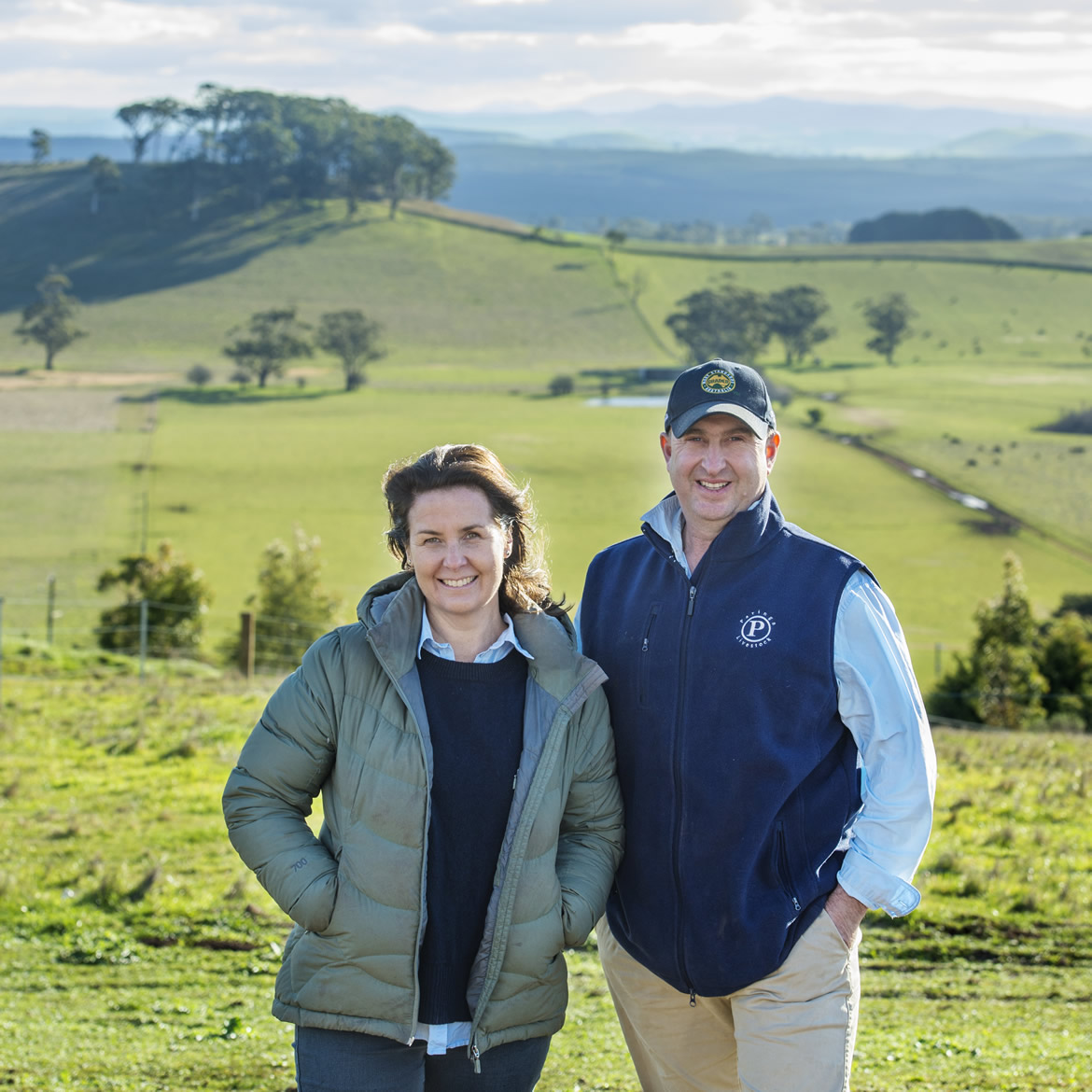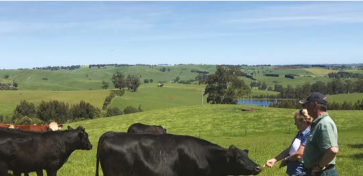| Property | Paringa |
| Area | 550ha |
| Enterprise | Cattle breeding. Angus and Stabilizer |
| Pasture | 20% native, 70% mixed perennials and 10% annual rye and clover |
| Soil | Clarkes Hill: heavy red volcanic basalt Yea: sedimentary hill gravel – clay loam |
| Rainfall | 650-750mm/year |
Victorian cattle producers Olivia and Tom Lawson, Paringa Livestock, have their sights set on a recipe to improve productivity and carbon neutrality.
They see genetics that drive higher reproductive rates and faster turn-off, combined with grazing management that promotes carbon storage, as important to reducing carbon footprint for southern beef producers.
“Our journey in this space started in the late 90s as a management decision to centre our operation on biological systems and rotational grazing using large mobs of cattle – growing soil carbon was a side benefit of that,” Olivia said.
“We also realised what can be achieved using genetic selection to reduce emissions using feed intake, feed efficiency, and easily measured traits such as fertility and longevity, and the use of planned cross-breeding systems.
“Sustainability means much more to us than just carbon. It’s a holistic approach across our business; the importance of biodiversity, low stress stock handling, animal welfare, health and performance, 100% ground cover, and people.”
The right ingredients
For the past 10 years, Paringa Livestock has incorporated feed efficiency-tested genetics from America, New Zealand and Australia.
Using a selection Index called $Profit®, Tom Lawson said such genetics delivered emissions reductions via faster turn-off (which means animals emit less methane in their lifetime) and lifting reproductive outcomes, such as weaning rates and weights.
Tom and Olivia introduced the Stabilizer® planned crossbreeding system to Australia, which can potentially produce 20% more beef per hectare and reduce carbon impact (as reduced carbon dioxide equivalent emissions) by 38%.
They’ve also focused on carbon storage and reducing emissions for more than 10 years through a vegetation improvement program.
Expansion is constrained in an area with high productivity and land values, so they’ve had to think strategically about planting areas. Strategies include:
- fencing off remnant native trees and replanting around them
- fencing off waterways and replacing with local indigenous grasses, shrubs and tree species, with water reticulated to troughs.
These tree plantings contribute to stored carbon on Olivia and Tom’s properties, as well as providing benefits such as shade and shelter for livestock, which supports productivity.
“We are still learning as we go, but our goal is to operate in large cow mobs, and rotate on grass with zero supplementary feed. We have a rule that if we have our grazing system set up properly, and stocking density right, we should never have to feed a cow.”
Digging deeper into soil carbon
To better understand what exactly makes a difference when calculating a beef enterprise’s carbon account, Tom and Olivia participated in Meat & Livestock Australia (MLA) carbon accounting workshop in 2020.
They learned that the two key parts of carbon accounting are calculating emissions, and calculating stored carbon.
“I’ve been looking into carbon accounting in more detail in the past 18 months and we’re keen to support the industry goal of achieving carbon neutrality,” Olivia said.
Olivia and Tom both have agricultural science degrees with Tom specialising in animal science and Olivia in agri-marketing – providing a useful background as they head towards carbon neutrality.
The pair were awarded the Victorian Landcare Sustainable Farming Award in 2014, and in 2020 they were named the Coles Weekly Times Beef Farmer of the Year award.
“We know that with appropriate land management and grazing techniques using ruminants, it is possible to increase soil carbon levels without relying on inputs such as fertiliser. We aim to ensure 100% ground cover 100% of the time, which reduces soil erosion, allows grass to recover after long dry periods, and reduces evaporation,” Olivia said.
“We get excited when the tractor sits in the shed for a long time; it means our grazing system is set up well, our soils are biologically balanced, carbon is being sequestered and our plants and livestock are performing.”
Revegetation for carbon sink: tree planting
- consider tree planting in marginal areas or fencing off conservation areas in the context of the whole- farm system and your goals for your operation.
- consider the other benefits of tree planting, such as shade and shelter for livestock, which can increase productivity, and reduce evaporation in soils and pastures.
- explore new financial opportunities arising to reward land stewardship and biodiversity; for example the new pilot carbon and biodiversity program through the Federal Government.
Animal welfare supports sustainability
Olivia said their participation in the Greenham NEVER EVER program had placed a greater focus on the importance of animal welfare practices.
“The use of polled genetics to negate de-horning, low-stress stock handling techniques, improved yard design, and pain relief products and use,” she said.
“Our journey in sustainable beef breeding and production has taught us the importance of keeping things simple: breed productive easy-care cattle and closely monitor your grazing system.
“It is easy when you select genetics that are highly efficient, fertile, and low maintenance. Really important not to get lured into buying large frame, high intake genetics that may visually look impressive but don’t fit your program. We would rather run more cows and breed more calves for less.”
Practical steps
Tom and Olivia are also improving their carbon footprint in other areas:
- Genetics: Increased production efficiency and weight for age are key methods for reducing livestock emissions intensity.
“Implementing a well-managed crossbreeding program is the simplest and lowest cost way to increase efficiency and weight for age,” Olivia said.
Paringa Livestock measures, monitors and benchmarks its genetic progress through Australia’s BREEDPLAN and the global $Profit® database, which compares purebred and multi-breed genetics around the world.
- Soil management: Data from baseline soil carbon measurements are required for soil carbon management to be considered in a carbon account.
When Tom and Olivia first measured their agronomic soil carbon 10 years ago it was at 2% – two years later it was at 4%.
Olivia suspects their soil carbon may have doubled again due to actions such as:
- use of intensive rotational grazing systems and multi-species pasture cropping.
- applying a sugar-based liquid (mixed with glyphosate in the sprayer) when spraying pastures out to feed soil biology, as part of their pasture improvement program.
- using compost and mineral-based fertilisers instead of synthetic.
- sowing new multi-species perennial pastures using zero tillage at depth when improvement is needed.
“Optimal livestock management through planned grazing systems is key to growing soil carbon and improving soil biology,” Olivia said.
Cattle are managed in large mobs based on year groups in a rotational grazing system of high-intensity intervals to maximise year-round ground cover.
“Managing stock density and rest periods are key to overall soil and plant health,” Olivia said.
Olivia and Tom aim to continue to make soil carbon gains by reducing paddock sizes and increasing watering points to accelerate the intensity of rotations.
Key points
- rotational grazing generates soil biology and carbon
- sequestering soil carbon offsets livestock emissions
- beef sustainability requires a blend of the right genetics, animal welfare and grazing management.
Carbon accounting tools
Here is a list of three free carbon accounting tools producers can access online today:
Integrity Ag’s carbon footprintassessment tool: https:// www.integrityag.net.au/simplifiedcarbonassessmenttool
Zero30 Beef Farmer Carbon TrackerTool: https://zero30.org.au/zero30-beef-farmer-carbon-tracker-tool/
University of Melbourne carbon accounting calculator: http://www.piccc.org.au/resources/Tools













